Photographing Philippine Mosques
In the 14th century, there was no Philippine nation, at least not in the political concept of a united archipelago of 7,107 islands under one government. What were extant were settlements and states called barangays, self-sustaining mostly but nonetheless trading on a regular basis with the Chinese, the Arabs and the Javanese. Islam was but a product of the cultural exchange with neighborhood islands that are now part of Malaysia and Indonesia in particular and Moghul India by extension.
Islam went far north in Luzon, even establishing a stronghold in Manila, although most of the islands remained animist with some elements of Hinduism and Buddhism. The fabric of history changed however when the Spanish came in 1521 and the subsequent imperialistic push of the Spaniards in the later part of the century became such a success that Islam’s hold in the country slipped. Today, Filipino Muslims comprise only about 5% of the population and are concentrated in the southern part of Mindanao.
The Muslim tradition in the South is understandably rich. In the 19th century, the power of the Islamic sultanate of Sulu was of significant import that its sovereignty extended as far as Sabah which it actually owned. Ethnologically, Muslim Philippines is not a single society but highly diverse. There are three main groups, the Maguindanao, the Maranaos and the Tausugs. Other subgroups are smaller and are marked by a different language and unique indigenous cultures, like the Samals and Badjaos of Sulu and the Yakans of Basilan.
Diverse they may be, these groups are united, firmly and inexorably, by religion. In this context, it became an exciting venture for me to photographically document the one identifiable symbol of the Islamic religion –the mosque or the holy place of worship.
I have been lucky to be a frequent visitor to the Sulu archipelago and these photographs specifically center on the mosques in Tawi-Tawi, the southernmost province in the country. These gems are definitively lesser seen by the majority of the Filipinos, but no less outstanding for their distillation of the Islamic esthetics.
Mosque of Makhdum, Simunul Island, Tawi-Tawi, the Philippines
Islam was introduced in the Philippines by the Arabian missionary Sheik Karin UI Makhdum. He built the the first Muslim mosque in 1380 A.D. in the small island of Simunul just across Bongao, the capital of Tawi-Tawi. Primarily fashioned of logs, the mosque in Tubig Indangan expanded as the population and the popularity of the religion grew.
Since its foundation, it still is a functioning mosque. Today, the mosque of Makhdum is a national monument and is an acknowledged mecca of the Philippine and Asian Muslim religious. Every Friday is a busy affair where scholars, students and the faithful gather as a community of believers.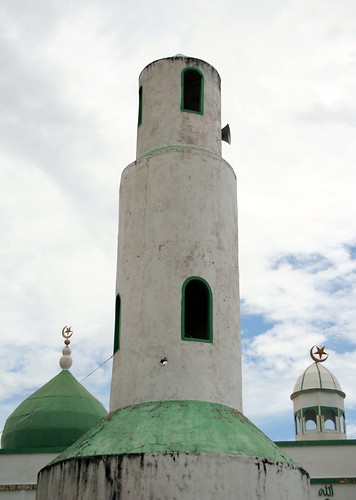
Canon EOS 350D Digital, 1/800s, f/6.3, 34mm, ISO 100
the mosque of Makhdum, Tubig Indangan, Simunul Island, Tawi-Tawi province, Autonomous Region of Muslim Mindanao, the Philippines 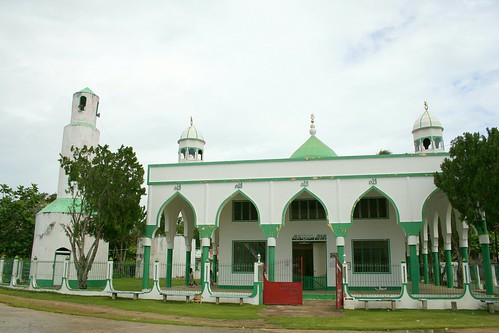
Canon EOS 350D Digital, 1/1000s, f/5.6, 18mm, ISO 100, -1/3 EV
full view of the mosque in of Makhdum, Tubig Indangan, Simunul Island, Tawi-Tawi, the Philippines
The Sheik Makhdum continues to enjoy local mythical status. His legend includes that of a powerful imam who can lift 3-foot diameter pillars. His remains is being claimed to have been buried by two separate islands, one of which is Simunul of course. Both graveyards are claimed to be “growing” or “rising” to this day.
Canon EOS 350D Digital, 1/160s, f/5.6, 25mm, ISO 800, -1/3 EV
one of four remaining pillars inside the mosque of Makhdum, Tubig Indangan, Simunul Island, Tawi-Tawi, the Philippines
the Makhdum Memorial, Sibutu island, Tawi-Tawi, the Philippines
The “other” claimant as the burial place of the Sheikh is Sibutu island, a municipality that used to be part of Sitangkai, the last set of islands that is nearer to Sabah, Malaysia than the main island of Mindanao itself. In Sibutu now stands a colorful and still unfinished memorial in honor of the Sheikh. Behind the memorial is the graveyard of the Sheikh which is just a plain marked mound of dirt.
Canon EOS 350D Digital, 1/800s, f/5.6, 18mm, ISO 100
Makhdum memorial, Sibutu, Tawi-Tawi, the Philippines
the Mosques of Sibutu, Tawi-Tawi, the Philippines
Probably the biggest mosque in Sibutu is the one in Tandubanak. Sporting a pink and green motif, it stands proudly alongside the narrow and singular road that bisects the island. Without any wide angle lens, it is difficult to capture the full breadth of the beautiful mosque so the next best alternative is to show how stately it stands out against the wooden houses of stilts that are typical of Tawi-Tawi.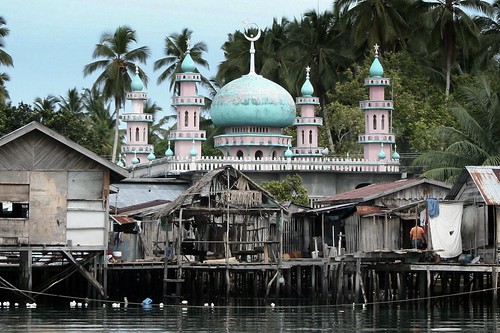
Canon EOS 350D Digital, 1/100s, f/11, 55mm, ISO 100
the Masjid of Tandubanak in Sibutu island, Tawi-Tawi, the Philippines
Sibutu is a poor municipality. Its main source of livelihood is the open seas, most importantly seaweed cultivation, as well as the more traditional fishing. The economic constriction of the community does not preclude the people from sprucing up their mosques. Below is a mosque in Ligayen with its dome made of hammered GI sheets. The paint is flaking but the crescent stands proud as always.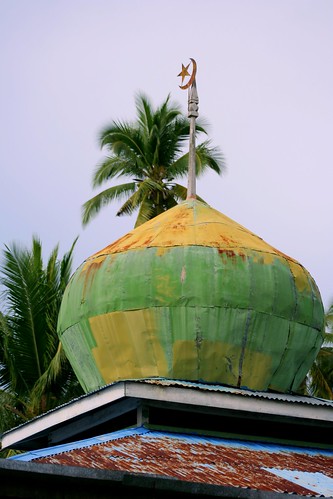
Canon EOS 350D Digital, 1/1000s, f/4.0, 75mm, ISO 100
the dome of the mosque of Ligayen, Sibutu, Tawi-Tawi, the Philippines
Masjid Haji Imam, Sitangkai, Tawi-Tawi, the Philippines
Sitangkai is an anomaly even in Muslim Philippines. The 25,000 people or so living in Sitangki chose not to live in the speck of the island but rather on a network of house of stilts on the reef, connected by walkways and manmade causeways. The main population belong to the Samal and the Badjaos, both of whom find it unimaginable to live on “enchanted” and “wild” land (kappat). The island is where you can find though the graveyards, the military detachment, the schools and of course, the main mosque of Haji Imam, the oldest in Sitangkai. It features four tall minarets and a golden dome.
Canon EOS 350D Digital, 1/100s, f/5.6, 18mm, ISO 100, -1/3 EV
Masjid Haji Imam, Sitangkai, Tawi-Tawi, the Philippines 
Canon EOS 350D Digital, 6.0s, f/5.6, 300mm, ISO 100
the golden dome of Masjid Haji Imam, Sitangkai, Tawi-Tawi, the Philippines
Musholla in the Capitol, Bongao, Tawi-Tawi
To cap the tour of mosques of the province of Tawi-Tawi, I will end in its capital in Bongao. Being part of the Autonomous Region of Muslim Mindanao, Tawi-Tawi has a provincial capitol building that has a musholla (Muslim prayer room) in its topmost foor. Flanked with watchtower minarets at the corners, the capitol is located on the hill overlooking the entire poblacion (town center).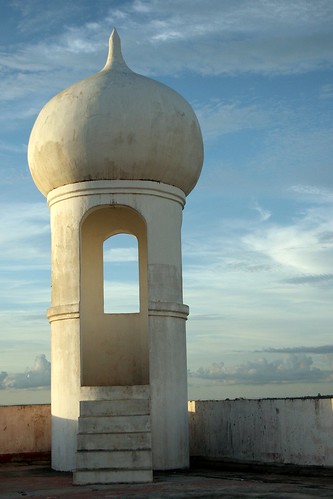
Canon EOS 350D Digital, 1/1250s, f/5.6, 37mm, ISO 400
a corner minaret at the Provincial Capitol of Bongao, the capital of Tawi-Tawi province, Autonomous Region of Muslim Mindanao, the Philippines
The musholla’s interior is modern and sparse. Its walls and floors are made of hardwood. As in mosques, this one has no furnitures. In the picture below, you can only see a clock, a Koran bookstand and several sajada prayer carpets.
Canon EOS 350D Digital, 0.4s, f/5.6, 18mm, ISO 400
the musholla at the Bongao Capitol, Bongao, Tawi-Tawi, the Philippines






14 comments:
Fascinating explaination of the origins of the Muslim religion as well as beautiful photographs.
Well done.
WOW, you made me so homesick for your beautiful islands, I can hardly breath. I am an Austrian who fell in love with a Filipino and the islands. After the earthquake of 1990 I left back to Austria, but in my thoughts I live every second of my life in the islands. Thank you for posting your research and photos. God bless you and your family.
Kindest regards
Sigrun Campos-Engel
Hi Farl - this is Micheal - (Verticordia)
These photos meaningful to me in a very deep almost sacred sense. This post is very wonderful...You are correct they are rarely seen by the Filipino and even more rare here in the US. The area you are in has been known to be inhospitable to westerners. Need i explain? That is not my point though. These are not the only structures, there are others, more modern. There is some very interesting history. But more so there is some very interesting present day life.
There are areas where Muslims and Catholics live side by side. My Fiancee's home town and Barangay held my interest in these matters. It is very sad that she thwarted this and committed fraud in the process. I wanted to do a thesis/dissertation/photo essay/marketing and build a business and they were intertwined with the very subjects of your post. There were two distinct books i wanted to publish that would be inter-related and tied to a business and i wanted it to have integrity and be very respectful. After all it was meant to benefit my new family most. I wanted to make it simple and accessible. The relationship was an important component. Her Barangay and family were important to this too. That is why i mention her. It is to give you an idea how deeply i appreciate these photos and your essay.
Even though i am very angry about what happened - there was much lost. In the process, i got to see something very wonderful. It began 9 years ago while I was searching for Large Tapioca Pearls or Sagu Pearls. I got on the net and ran across this my first Fiancee a Filipina. I wanted to create a Bubble Tea franchise or something like that... She was poor and i was 'relatively' poor. We seemed to have a great relationship. I wanted to leverage our story and the culture - it became very relevant to me. It fit perfectly with what i was doing. It was as though i had found the treasure I was hunting for. i found it very relevant to the times. She was business partner and she thwarted all our efforts. Needless to say at least 2 Pearl Shake Franchises came into being there not long afterwards. The entrepreneurs that developed them made millions but did not make headway into the international franchises. aaaa...
However, here i am now and these photos and this essay is very meaningful to me. I am not Muslim. I wouldn't even call myself a Christian. It's meaningful to me for many reasons. The Philippines was America's first foray into colonization. I am sure you know the history. To me it was very relevant and I cared deeply about this woman, i came to love the Philippines in a very real way. The culture spoke deeply to my heart. I was very disillusioned at that time with the escalation of Muslim Christian tensions and with the wayward and thoughtless asserting of powers. I may comprehend the strategic reasonings but i was very disappointed in the execution of many things. However, this is not a politics it's about people living together in their differences, responsibly. It really is horrific that this girl turned out to be a fraud. There is a lot to the story. However, my love for the Philippines was not diminished. It grows stronger everyday. I felt at home and not because things were perfect not everybody was nice. That includes some of my hosts. I did not stay in a resort when i came. I did not go to the beach. I stayed in the town she was living in. We stayed around the corner from the jail. We walked the streets at night and had to duck the stones that Rugby boys were throwing at each other as we passed by the high school at night. We got run over by a typhoon and had to hunt all over town for candles for days. We lugged 5 gal jugs of water for blocks. We ate at Greenwich and Jolliebee and did our grocery shopping at Uni-mart and the market. I got an aweful tooth ache and was gobbling mafalanic acid. We had no air conditioning and no electricity for a week and it was hot and humid. All I am saying is that I felt at home and not because everybody was nice and all things were perfect. I was talking about building a franchise there from our sweat, from the ground up. I was there not with fists full of corporate money out on vacation. I was there in the midst the competition at street level. I tell you this so you know how deeply i appreciate this blog entry.
I have a new Fiancee in Pangasinan and her brother-in-law is a Muslim. I did not chose her because of this, nor because she was Filipino, it just happened again. She raises her sister's son. His name is Rasheed. They work together but there is a strain between the family and her Ate and husband, due to some of his behavior and also because of religious differences. Well, anyway this is not the same situation as my last Fiancee. I am just saying, I am deeply moved and appreciate this entry. Thank you Farl, I sincerely think that the Filipino are the most beautiful people in the world and i don't mean their external looks they have wonderful hearts. Above you spoke of their original tribal structure in Barangays - i sincerely hope that this will always be so and honestly, i believe it far from over for this structure. I believe there are little self-contained islands becoming all over the world. I am impressed and moved deeply.
~Micky, just a lowly artist :)
Oh my goodness! I just read sigrun's comment - WOW, you made me so homesick...
God Bless you and your family always!
~Michael
Dear Mr. Farl,
Thank you very much for digitizing the Bangsamoro images for all posterity to learn and enjoy.
I hope someday that I will be able to meet you, shake your hand and thank you personally from the bottom of my heart.
Ang galing mo, you are one of the few.
hello...
wow!!!.. i really appreciate your photo journeys bout my province most especially of my home town sitangkai..., and its a wonderful.
I am glad that you all found this blog worthwhile. I hope to be able to visit Tawi-Tawi this year once again.
thanks farl for your messages...i really touched for ervery words..God bless u
thanks farl
Salam farl..your blog is very interesting and encouraging. You inspired me to do the same, all the mosque you posted were very close to my heart especially the masjid in Sitangkai we called it locally masjid awwal. I used to pray there every friday now i am more inspired to visit and pray also in the other mosque you posted inshaallah. Nice job brother May God grant you more strength and knowledge so that you can post and write more..this is aldrin from Saudi Arabia.
Thank you for sharing your pictures on PHilippine mosques. I am an academic writing as essay on mosques and have some questions. May I email you directly?
Vivienne SM. Angeles
Dept. of Religtion
La Salle University
Philadelphia, PA. 19141
USA
angeles@lasalle.edu
I was researching, on my own personal capacity, on Islam in the Philippines when I got to your website. Thanks so much. your writings and photos confirmed most that I read about the history of Islam and its early days in the Philippines.
Keep it up. Nice shots too. time to change to Canon 500D.
I was researching,on my personal capacity, on Islam in the Philippines when I bumped into your website. Your writings and photos confirmed much of my understanding of the early history and the arrival of Islam into Sulu and the Philippines.
Great job. Nice shots too. Time to change to 500D.
Thanks for the blog
loves Turkey
Post a Comment